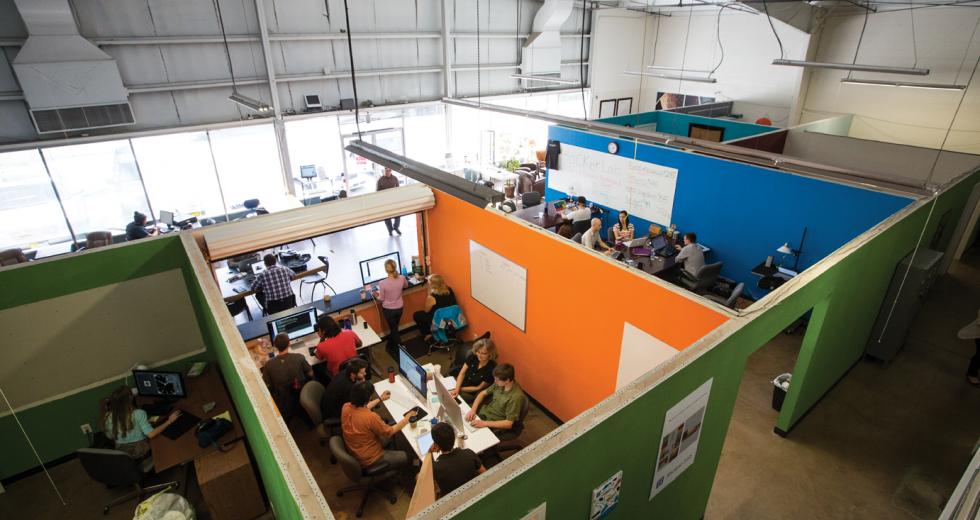When Hacker Lab outgrew 800 square feet on Franklin Boulevard last year, the founders needed more than additional space. They needed a change of scenery.
“We needed to be in the downtown area and needed to be near coffee, beer and food. … Beer makes everything better,” says Eric Ullrich, co-founder of Hacker Lab. “Well, there were a couple of other things, too.”
The technology incubator was looking for 3,000 to 5,000 square feet it could use to sublet private offices to startups, sell memberships for co-working space and hold nerd gatherings, such as a movie night featuring “Weird Science.” The founders ended up with 10,500 square feet, and they’re using every inch.
It wasn’t an easy deal to broker, but a key ingredient to Hacker Lab’s success was a building owner willing to take a chance. The organization was less than a year old and had a limited budget, says broker Brian Jacks, regional vice president of East West Commercial Real Estate. Jacks landed his client a below-market rent that increases to market rate over the life of the two-year lease.
Cheap rent, short leases and little credit history are all common for the technology industry, which might seem counterintuitive to Capital Region building owners looking for stable tenants. But there’s a glut of vacancies on the market and a push to lure more private-sector jobs. If the region wants to make real estate attractive to the next generation of techies, building owners may need to change rigid views about lease space, and developers may need to reconsider concrete business labyrinths in the suburbs.
Attracting innovative companies is among the top priorities outlined in the Next Economy report released last March by the Center for Strategic Economic Research. Today, nearly 30 percent of jobs in the region are in the government sector, and commercial office space reflects these workspaces.
“It is difficult for tech companies to find suitable turn-key space in Sacramento, since there isn’t nearly as much to choose from as, say, San Jose,” Jacks says. “Tech tenants can choose from traditional space, which is cheap, but then pay to convert it for their specific needs, or they can convert already existing tech space, which will cost money, too.”
If economic developers are successful in luring and fostering startups, it could mean a big payout for real estate down the road. In 2010, the top five commercial real estate markets in the U.S. also led the nation in venture capital raised, according to a Cassidy Turley analysis. But while startups are fuelling a flurry of deals in Silicon Valley and San Francisco, the Capital Region is still lagging light-years behind.
In the fourth quarter last year, the Sacramento region saw one venture investment totalling $1 million, according to a PricewaterhouseCoopers MoneyTree survey. The entire Bay Area saw 309 deals totalling $2.54 billion — roughly 40 percent of the total for the U.S. during that quarter.
So, maybe the Capital Region’s real estate industry shouldn’t be bracing for a hurricane of high-tech deals anytime soon. Still, the overnight success of Hacker Lab is an indicator of the pent-up demand to foster innovation in the region. On any given day, about 65 members use the co-working space, Ullrich says. Without Hacker Lab, these are inventors and entrepreneurs who would otherwise be found in coffee shops, garages or their parents’ basements.
Outside of downtown, offices at the Palladio in Folsom have attracted four tech companies the past year. Major draws are its location in the lifestyle center and its trendy design, says Breanna Hegseth, a senior associate with Cornish & Carey Commercial Newmark Knight Frank. And tech tenants love trendy space. According to one Cushman & Wakefield report, San Francisco landlords have recently spent upward of $400 million transforming generic offices into more creative spaces to lure tech tenants.
In addition to appealing to younger workers, tech space requires different considerations than traditional businesses, says Hegseth.
“The challenge with tech-related companies is that they generally grow quickly, so they are a little more volatile,” she says. “As a result, there are more provisions in their leases that they try to include, such as an option to terminate. And they need to accommodate future growth.”
And what about guaranteeing the lease? Startups don’t have a long history to demonstrate credit or years of profits. In fact, a tech company might incur losses and still be considered a leader in its industry.
“A lot of that depends on the level of improvements the landlord is being asked to contribute and other costs they are having to accommodate,” Hegseth says. “Some landlords are much better at looking into the tenant and their specific sector in the industry and underwriting them that way, rather than just looking at the time they’ve been in business.”
The Next Economy report suggests the region has suitable commercial real estate to lure a variety of industries, but it lacks an entrepreneurial environment, access to capital and “low-cost incubation space” that’s specific to tech. What sets incubation space apart from co-working space is the addition of support services, such as mentoring and introductions to venture capitalists.
“At the time the report was written, there was a need for more physical locations where early-stage tech can cluster together,” says Meg Arnold, CEO of the Sacramento Area Regional Technology Alliance. “In the year since the report has been written, there have been some meaningful movements on that front. Hacker Lab and Capsity (another Sacramento co-working space) are contributing to bringing more incubator space into existence.”
SARTA operates a small incubator called VentureLab, which has five companies working out of its site at Power Inn Road. Arnold says the Capital Region is spread out and needs more incubators to cover the geographic area. Incubators could be an opportunity for a building owner or developer to start a relationship with several small clients, but it comes at a cost.
The first thing a successful incubator needs is below-market rent or, better yet, free rent, says Ingrid Rosten, VentureLab manager and director of SARTA’s Cleanstart program. Rosten has worked with incubators and accelerators in the Bay Area.
“If a building owner has a big empty building, it may behoove them to give a floor to an incubator or accelerator with the intention of marketing the building,” she says. “We did that in San Jose. I had a 14,000-square-foot floor, and we encouraged other clients to take space in the building. We actually managed to help the landlord rent out another 28,000 square feet.”
When startups leave incubators and look for their own leases, amenities such as restaurants and a place to have a beer are important because of their young workforce. Rosten says midtown or West Sacramento’s future Bridge District are ideal.
“It’s a younger crowd, so it’s got to be a place where the young entrepreneurs and incubator-types would want to hang out,” she says.
A place to hang out is part of what’s made Hacker Lab so successful. It started as a meetup.com group last February. By summer, founders were trying to convince landlords to rent them a larger space. Today, its 12 private offices are rented out with a waiting list, dozens of ideas are hatching in the co-working space, and they’re holding 20-plus tech and entrepreneur-related events a month.
“We’re just getting started,” Ullrich says. “Now, building out the community is really where it’s at.”
Recommended For You

Putting the Fab in Pre-Fab
Modular construction cuts construction and energy costs
The final stages of construction at a trend-setting apartment project in San Francisco’s SoMa neighborhood, known by its address at 38 Harriett St., largely resembled a life-sized game of Tetris.

Relationship Troubles
Are state workers the best pick for upgrading California’s massive IT systems?
In 1984, California’s Department of Technology didn’t exist. Information technology consultants were rare, and there were fewer contractors involved in state services. For the most part, the state developed government systems with in-house resources. From development and analysis to budgeting and implementation, it was a full-service operation.
That was then.



